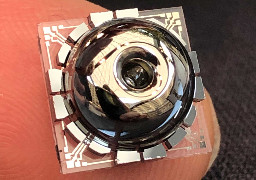




 |
 |
 |
|||
 |
 |
 |
 |
 | |
 |
 |
 | |


| 미디어 브리핑스 | 내서재담기 |


  |
 |  |
어떤 신기술이 세상을 극적으로 변화시킬까? 세계 최고의 연구소에서 나오는 놀라운 혁신을 독점 소개합니다.
* *
1만 배 더 정확해지는 자이로스코프 개발
대부분의 스마트 폰에는 자이로스코프(Gyroscope)가 내장되어 있어 화면의 방향을 감지하고 화면이 어디를 향하고 있는지를 알아내지만 사실 그 정확도는 그다지 높지 않다. 내비게이션 기능을 사용하는 중 사용자가 향하고 있는 방향을 잘 못 나타내는 경우가 종종 있는데 바로 이러한 이유 때문이다.
사람이 길거리에 있거나 운전 중일 때 이것은 사실 큰 문제는 아니다. 그러나 자율 주행 자동차의 경우는 그렇지 않다. GPS 신호를 없어지면 이러한 자동차는 곧바로 혼란에 빠지기 때문이다. 따라서 백업 내비게이션 시스템 내에서 오늘날의 자율 주행 자동차는 더 크고 비싼 고성능 자이로스코프를 사용한다.
이러한 이유로 오늘날의 고성능 자이로스코프는 자율 주행 자동차 산업에서 하나의 장애물이다. 이 문제는 꽤 오랫동안 해결되지 못했다. 그러나 최근 미시간 대학교에서 개발된 작고 저렴하며 고도의 정밀도를 제공하는 자이로스코프가 이러한 장애물을 제거할 것 같다. 대부분의 자율 주행 자동차에 고도로 정밀하면서도 비용은 저렴한 관성 내비게이션을 제공해줄 수 있기 때문이다. 이 새로운 자이로스코프는 1만 배 더 정확하지만 가격은 현재 일반 휴대 전화에 사용되는 자이로스코프보다 10배 정도 더 비싸다. 그러나 이 자이로스코프는 비슷한 성능을 지닌 ? 현재 자율 주행 자동차에 적용되는 - 훨씬 큰 자이로스코프보다 가격이 1,000배 더 저렴하다.
이 자이로스코프는 GPS 신호가 혼잡한 지역에서 군인들이 경로를 찾는 데 도움을 줄 수 있는 보다 향상된 백업 내비게이션 시스템의 핵심을 구성할 수 있다. 조금 더 일상적으로 보면, 정확한 실내 내비게이션 능력은 창고나 물류 로봇들의 속도를 더 빠르게 만들 수 있다.
지속적인 방향신호 없이 내비게이션을 가능하게 하는 장치를 관성 측정 장치라 부른다. 이 장치는 3개의 가속도계와 3개의 자이로스코프로 구성되는데, 각각 공간의 한 축을 맡는다. 그러나 기존 관성 측정 장치를 활용하여 이것을 해내려면 너무나 큰 비용이 드는데, 이 비용은 자율 주행 자동차에 적용하기에도 버거울 정도다.
미시건 대학교가 개발한 자이로스코프가 저렴한 이유는 이것이 거의 대칭적인 기계식 공진기를 갖춘 작은 자이로스코프라는 데 있다. 이 자이로스코프는 와인 잔과 비슷한 도넛 모양으로 크기가 약 1cm이다. 와인 잔이 부딪칠 때 생기는 소리의 지속 시간은 미학적 특성이 아니라 유리의 품질에 달려 있다. 마찬가지로 이러한 울림이 이 자이로스코프의 기능에 매우 중요하다. 이 완전한 장치는 유리 공진기 주위에 놓인 전극을 활용하여, 유리를 밀고 당기면서 울림을 만들고 그것을 계속 유지한다.
유리 공진기는 지정된 패턴으로 진동하며 갑자기 회전하면 진동 패턴이 원래 방향으로 유지되는데, 이에 따라 진동 패턴을 모니터링하여 회전 속도와 각도를 직접 측정할 수 있는 것이다. 진동 운동이 유리를 통과하는 방식이 공간에서 자이로스코프가 얼마나 빨리 그리고 얼마나 많이 회전하는지를 나타낸다.
이 유리 공진기를 최대한 완벽하게 만들기 위해, 미시간 대학 연구팀은 약 1/4mm 두께의, 용융 실리카(fused-silica)로 알려진 매우 이상적인 순수 유리 시트로 시작했다. 이들은 소형 발염(發炎) 장치를 사용하여 유리를 가열한 후 도넛 모양의 유리 공진기로 성형했다.
이후, 금속 코팅을 하고, 그 주변에 전극을 배치하여 유리에 진동을 일으키고 측정했다. 이 모든 과정은 진공으로 진행되었다. 미 국방연구계획국(DARPA)이 자금을 지원한 이 연구는 최근 관성 센서 및 시스템에 관한 제7회 IEEE 국제 심포지엄에서 발표되었다.
- University of Michigan, March 23, 2020, “Small, Precise and Affordable Gyroscope for Navigating without GPS,” Nicole Casal Moore and Kate McAlpine. ⓒ 2020 The Regents of the University of Michigan. All rights reserved.
To view or purchase this article, please visit:
https://news.umich.edu/small-precise-and-affordable-gyroscope-for-navigating-without-gps/
 |  |
Global Technology
Most smartphones contain gyroscopes to detect the orientation of the screen and help figure out which way it is facing, but their accuracy is poor. They’re the reason why phones often incorrectly indicate which direction a user is facing during navigation.
It doesn’t matter much to a human on the street or behind the wheel, but a driverless car could get lost quickly with a loss of GPS signal. Inside their backup navigation systems, autonomous vehicles currently use high-performance gyroscopes that are larger and much more expensive.
However, high-performance gyroscopes are a bottleneck, and they have been for a long time. And now, a small, inexpensive, and highly accurate gyroscope developed at the University of Michigan can remove this bottleneck by enabling the use of high-precision and low-cost inertial navigation in most autonomous vehicles. The new gyroscope is 10,000 times more accurate but only ten times more expensive than the gyroscopes now used in your typical cell phone. Importantly, this gyroscope is 1,000 times less expensive than much larger gyroscopes with similar performance.
It could form the core of an improved backup navigation system that could help soldiers find their way in areas where GPS signals have been jammed. Or, in a more mundane scenario, accurate indoor navigation could speed up warehouse robots.
The device that enables navigation without a consistent orienting signal is called an inertial measurement unit. It is made up of three accelerometers and three gyroscopes, one for each axis in space. But getting a good read on which way you’re going with existing inertial measurement units is so expensive that they have been out of range for most applications, even for applications as expensive as autonomous automobiles.
The key to making this affordable is a small gyroscope with a nearly symmetrical mechanical resonator. It looks like a one centimeter wide “Bundt pan” crossed with a wine glass. As with wine glasses, the duration of the ringing tone produced when the glass is struck on the quality of the glass - but instead of being an aesthetic feature, the ring is crucial to the gyroscope’s function. The complete device uses electrodes placed around the glass resonator to push and pull on the glass, making it ring and keeping it going.
The glass resonator vibrates in a specified pattern, and if you suddenly rotate it, the vibrating pattern wants to stay in its original orientation. So, by monitoring the vibration pattern, it is possible to directly measure the rotation rate and angle. The way that the vibrating motion moves through the glass reveals when, how fast and by how much the gyroscope spins in space.
To make their resonators as perfect as possible, the Michigan team starts with a nearly ideal sheet of pure glass, known as fused-silica, about a quarter of a millimeter thick. They use a blowtorch to heat the glass and then mold it into a Bundt-like shape - known as a “birdbath resonator” since it also resembles an upside-down birdbath.
Then, they add a metallic coating to the shell and place electrodes around it that initiate and measure vibrations in the glass. The whole thing is encased in a vacuum package, about the footprint of a postage stamp and half a centimeter tall, which prevents air from damping out the vibrations.
The research, funded by DARPA, was recently presented at the 7th IEEE International Symposium on Inertial Sensors & Systems.
References
University of Michigan, March 23, 2020, “Small, Precise and Affordable Gyroscope for Navigating without GPS,” Nicole Casal Moore and Kate McAlpine. ⓒ 2020 The Regents of the University of Michigan. All rights reserved.
To view or purchase this article, please visit:
https://news.umich.edu/small-precise-and-affordable-gyroscope-for-navigating-without-gps/
*****************
An international team has developed a new method for generating quantum-entangled photons in a previously inaccessible spectral range, making the encryption of satellite-based communications much more secure in the future.
A 15-member research team from the UK, Germany, and Japan has developed a new method for generating and detecting quantum-entangled photons at a wavelength of 2.1 micrometers. In practice, entangled photons are used in encryption methods such as quantum key distribution to completely secure telecommunications between two partners against eavesdropping attempts. The research results are presented to the public for the first time in a recent issue of Science Advances.
Until now, it has been possible to implement such encryption mechanisms only in the near-infrared range of 700 to 1550 nanometers. These shorter wavelengths have disadvantages, especially in satellite-based communication, because they are disturbed by light-absorbing gases in the atmosphere as well as the background radiation of the sun. With the existing technology, end-to-end encryption of transmitted data can only be guaranteed at night.
Entangled photon pairs at two micrometers wavelength are significantly less influenced by the solar background radiation. Also, a so-called “transmission window” exists in the earth’s atmosphere for wavelengths of two micrometers. That means these photons are less absorbed by atmospheric gases, allowing more effective communication.
For their experiment, the researchers used a nonlinear crystal made of lithium niobate. When they sent ultrashort light pulses from a laser into the crystal a nonlinear interaction produced entangled photon pairs with a new wavelength of 2.1 micrometers.
The next crucial step will be to miniaturize this system by converting it into photonic integrated devices, making it suitable for mass production and use in other application scenarios.
References
Science Advances, March 27, 2020, “Two-Photon Quantum Interference and Entanglement at 2.1 μm,” by Shashi Prabhakar et al. ⓒ 2020 American Association for the Advancement of Science. All rights reserved.
To view or purchase this article, please visit
https://advances.sciencemag.org/content/6/13/eaay5195
